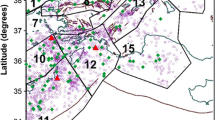Abstract
—The maximum likelihood estimation of earthquake hazard parameters has been made in the Himalayas and its surrounding areas on the basis of a procedure which utilizes data containing complete files of the most recent earthquakes. The entire earthquake catalogue used covers the period from 1900–1990. The maximum regional magnitude M max , the activity rate of the seismic event λ, the mean return period R of earthquakes with a certain lower magnitude M max≥ m along with their probability of occurrence, as well as the parameter b of of Gutenberg Richter magnitude-frequency relationship, have been determined for six different seismic zones of the Himalayas and its vicinity. It is shown that in general the hazard is higher in the zone NEI and BAN than the other four zones. The high difference of the b parameter and the hazard level from zone to zone reflect the high seismotectonic complexity and crustal heterogeneity.
Similar content being viewed by others
Author information
Authors and Affiliations
Additional information
Received March 25, 1997, accepted December 17, 1997.
Rights and permissions
About this article
Cite this article
Shanker, D., Sharma, M. Estimation of Seismic Hazard Parameters for the Himalayas and its Vicinity from Complete Data Files. Pure appl. geophys. 152, 267–279 (1998). https://doi.org/10.1007/s000240050154
Issue Date:
DOI: https://doi.org/10.1007/s000240050154




